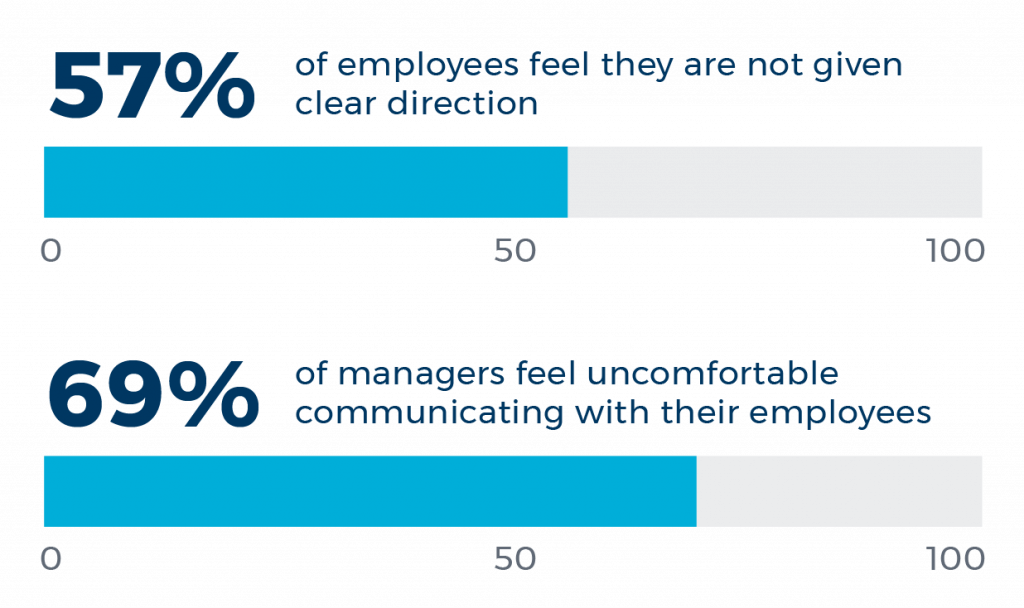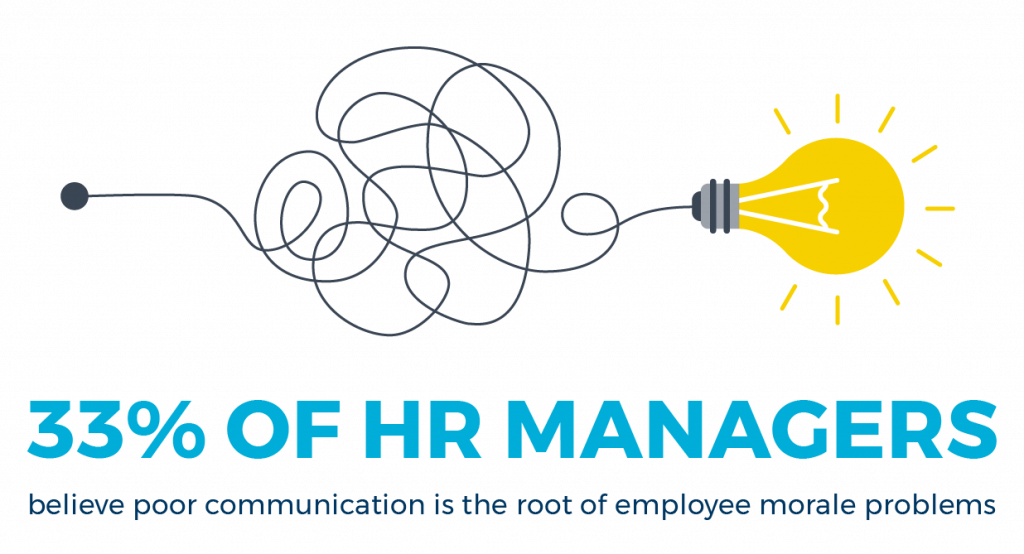
In all aspects of life, communication is key when it comes to success and happiness. But different situations and relationships require unique styles of communication. When ensuring morale is high and goals are met within your organization, knowing how to communicate effectively in the workplace is crucial. But how is effective communication produced and practiced? In this article, you’ll discover the tools needed to communicate effectively in the workplace and the benefits they embody.
What is effective communication in the workplace?
Effective communication in the workplace is the occurrence of ideas and information being exchanged accurately, ensuring employees are given the knowledge and tools they need to perform their jobs well.
The consistency with which they receive this information and who it’s provided by also plays an important role. If regular communication is not put into practice by leadership, employees are left feeling disconnected and unmotivated. In fact, statistics show 57% of employees feel they are not given clear directions, while 69% of managers don’t feel comfortable communicating with their employees.
Overall, communicating effectively in the workplace facilitates an environment where members of your organization can connect, feel empowered to ask questions, and reach their job roles’ full potential, which creates a healthy work environment and positive employee experience.

Workplace communication tools
There are several tools you can utilize to communicate effectively in the workplace. When polled, 33% of HR managers said poor communication is the primary cause of employee morale problems. By implementing a combination of the following, you’ll find your company’s goals to be widely understood and efficiently being worked toward, boosting morale and productivity.
#1. Internal Newsletters
Company newsletters are a tried and true method of workplace communication. If eye-catching and well-written, an internal newsletter can adequately provide important information to your employees.
#2. Blogs
Internal blogs are great for answering frequently asked questions, sharing important announcements, reinforcing policies, and encouraging discussion.
Subject experts within your organization can provide posts on their area of expertise, while senior executives can use blog posts to inform all levels of the organization on accomplishments and upcoming changes. The key to a successful blog is consistency, so update it regularly to ensure your employees see it.
#3. Surveys
Communicating effectively in the workplace is a two-way street. It’s crucial for management to ask for and honestly consider feedback from employees. Surveys are convenient tools that quickly gain opinions and insights about your organization’s employee experiences. Just be sure to take action upon receiving survey results. Otherwise, employees feel as though they aren’t being listened to, leaving them reluctant to participate in future surveys.
#4. Intranet
A company intranet is an ideal way to centralize news, documents, and essential information that covers various topics within your company. Employees can easily access otherwise hidden information that may take entirely too long to receive if depending on return phone calls or email replies.
Keep the news in your intranet up to date and relevant to ensure it reaches its full potential – as unkempt intranets can become overwhelming and hard to navigate – and communicating effectively in the workplace will be a breeze.

How to Declutter Your Intranet
In this whitepaper, learn 5 actionable steps you can take to begin decluttering your intranet, including:
- Establishing a data policy and sticking to it
- Taking inventory of the content within your intranet
- Paying attention to your own patterns
- And more!
ngthn Iternal Communication
#5. Instant Messaging
Instant messaging is a fast, easy way for employees to communicate with each other. Whether sending texts, videos, links, or photos, it’s much quicker than waiting for email replies and has become intuitive for most people since the rise of social media.
#6. Employee Apps
It’s important to recognize frontline employees who may not have regular access to a desktop computer during work hours. Implementing an employee app allows non-desk workers to stay up to date while on their feet via their mobile devices. Crisis alerts or quick-changing information can reach employees fast by sending notifications to their phones or tablets.
#7. Employee Recognition Software
Expressing an everyday “job well done” is easy to overlook. But letting your employees know they’re on the right track and meeting standards is crucial to communicate effectively in the workplace.
Only acknowledging mishaps and slipups can leave your employees feeling unappreciated, leading to turnover and difficulty recruiting. Implementing an employee recognition platform creates an easy and fun way to express kudos to your employees regularly.
Benefits of digital communication in the workplace
Digital communication tools are essential to communicate effectively in the workplace and can benefit your employees in imperative ways. We’ve made a list of the Top 5 ways digital communication tools benefit your organization.
#1. Community
Digital communication tools create an environment where frontline and deskbound workers can openly communicate. A space that allows employees to ask questions easily, collaborate, and connect will generate a sense of community. And when employees truly feel like a part of their organization, they stay happy & engaged, reducing turnover.
#2. Innovation
The ability to problem-solve and communicate in real time perpetuates innovation and idea generation. When employees have the ability to collaborate via digital communication tools, they can brainstorm & share feedback instantly. With easy-to-use digital communication tools, collaborative sessions will naturally become a part of your work culture, inspiring continuous growth and innovation.
#3. Knowledge Sharing
The sharing of information and knowledge is effortless using digital communication. File storage, co-authored documents, and intranet pages create accessible knowledge repositories, while instant messaging, blog posts, and newsletters allow the distribution of knowledge. Digitally published information also reaches individuals, teams, and departments faster than any other means of communication.

Centralizing Employee Resources
In this case study, learn how TCG, a fully-remote government contractor, used MangoApps to:
- Create a central repository of resources
- Track engagement and see which employees view content
- Bridge the gap between their workforce
#4. Accessibility
Mobile-friendly tools allow users to communicate effectively in and out of the workplace. Giving frontline and remote workers access to company news and resources via smart devices ensures everyone in your organization is connected and has the opportunity to learn, share, and be heard.
#5. Flexibility
As times change, so do workplace norms. The average office staff member now expects working from home to be an option at nearly any organization. Luckily, with digital communication tools, this is entirely possible.
Allowing employees to work from home if feeling a little sick, weather conditions make commuting unsafe, or their child is on holiday from school is considerate and makes them feel cared for. And instead of losing out on productivity, whether due to day-to-day or global disruption, they’re able and willing to do whatever work they can from home. When employees feel trusted, it positively impacts their experience, which aids in retention and recruitment.

MangoApps as a digital workplace communication tool
Ready to improve your organization’s communication? Consider MangoApps as your all-in-one digital solution. With a wide variety of collaboration and engagement features, MangoApps provides everything you need to communicate effectively in the workplace.
- From company newsletters to instant messaging, MangoApps’ communication tools keep employees engaged and in the know.
- Recognition capabilities, idea collection, and surveys reinforce your company’s core values while ensuring every employee’s voice is heard.
- Centralized knowledge repositories comprised of branded company pages, editable wikis, and more make learning and information sharing effortless.
MangoApps provides all that and more! Communicate effectively in the workplace by eliminating misunderstandings and confusion with a dependable, easy-to-use digital workspace platform. To learn more about MangoApps, visit mangoapps.com or book a demo today!







